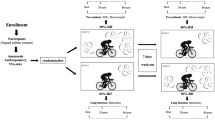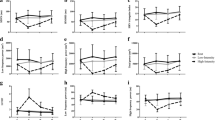Abstract
Exercise promotes pulmonary oxidative imbalance. In this regard, some evidence has been obtained from the study of exhaled breath condensate (EBC) during urban races, in which the factors involved in the occurrence of this process are still not characterized. In this paper, under laboratory conditions, both the role of time of exercise on the generation of pro-oxidants (H2O2, NO2 −) and pH have been assessed in EBC of 16 under-trained subjects who completed three tests of cycloergometric exercise at low intensity (30 % of VO2 max) with a duration of 10, 30, and 90 min. Samples were obtained as follows: immediately before and at 80 min post exertion in each test. In the 90-min test, an increase in H2O2, NO2 − concentration in EBC at 80 min post exertion with no changes in the pH was observed. Total O2 consumption and total ventilation weakly correlated with the changes in H2O2 and NO2 −. In conclusion, the concentration of pro-oxidants in the EBC depends on the duration of the exercise when it is performed at low intensity under laboratory conditions.


Similar content being viewed by others
References
Araneda OF, Carbonell T, Tuesta M (2016) Update on the mechanisms of pulmonary inflammation and oxidative imbalance induced by exercise. Oxid Med Cell Longev 2016:4868536
Araneda OF, García C, Lagos N, Quiroga G, Cajigal J, Salazar MP, Behn C (2005) Lung oxidative stress as related to exercise and altitude. Lipid peroxidation evidence in exhaled breath condensate: a possible predictor of acute mountain sickness. Eur J Appl Physiol 95:383–390
Araneda OF, Guevara AJ, Contreras C, Lagos N, Berral FJ (2012) Exhaled breath condensate analysis after long distance races. Int J Sports Med 33:955–961
Araneda OF, Salazar MP (2009) Design and evaluation of a device for collecting exhaled breath condensate. J Bras Pneumol 35:69–72
Araneda OF, Tuesta M (2012) Lung oxidative damage by hypoxia. Oxid Med Cell Longev 2012:856918
Araneda OF, Urbina-Stagno R, Tuesta M, Haichelis D, Alvear M, Salazar MP, García C (2014) Increase of pro-oxidants with no evidence of lipid peroxidation in exhaled breath condensate after a 10-km race in non-athletes. J Physiol Biochem 70:107–115
Bikov A, Galffy G, Tamasi L, Bartusek D, Antus B, Losonczy G, Horvath I (2014) Exhaled breath condensate pH decreases during exercise-induced bronchoconstriction. Respirology 19:563–569
Bikov A, Lazar Z, Schandl K, Antus BM, Losonczy G, Horvath I (2011) Exercise changes volatiles in exhaled breath assessed by an electronic nose. Acta Physiol Hung 98:321–8
Burnham KJ, Arai TJ, Dubowitz DJ, Henderson AC, Holverda S, Buxton RB, Prisk GK, Hopkins SR (2009) Pulmonary perfusion heterogeneity is increased by sustained, heavy exercise in humans. J Appl Physiol 107:1559–1568
Carlisle AJ, Sharp NC (2001) Exercise and outdoor ambient air pollution. Br J Sports Med 35:214–222
Freed AN, Davis MS (1999) Hyperventilation with dry air increases airway surface fluid osmolality in canine peripheral airways. Am J Respir Crit Care Med 159:1101–1107
Gay CA, Gebicki JM (2002) Perchloric acid enhances sensitivity and reproducibility of the ferric-xylenol orange peroxide assay. Anal Biochem 304:42–46
Green LC, Wagner DA, Glogowski J, Skipper PL, Wishnok JS, Tannenbaum SR (1982) Analysis of nitrate, nitrite, and [15N]nitrate in biological fluids. Anal Biochem 126:131–138
Greenwald R, Ferdinands JM, Teague WG (2009) Ionic determinants of exhaled breath condensate pH before and after exercise in adolescent athletes. Pediatr Pulmonol 44:768–77
Heinicke I, Boehler A, Rechsteiner T, Bogdanova A, Jelkmann W, Hofer M, Rawlings P, Araneda OF, Behn C, Gassmann M, Heinicke K (2009) Moderate altitude but not additional endurance training increases markers of oxidative stress in exhaled breath condensate. Eur J Appl Physiol 106:599–604
Kostikas K, Papatheodorou G, Psathakis K, Panagou P, Loukides S (2003) Oxidative stress in expired breath condensate of patients with COPD. Chest 124:1373–1380
Marek E, Mückenhoff K, Streckert HJ, Becher G, Marek W (2008) Measurements of L-lactate and H2O2 in exhaled breath condensate at rest and mild to moderate exercise in young and healthy subjects. Pneumologie 62:541–547
Maroun MJ, Mehta S, Turcotte R, Cosio MG, Hussain SN (1995) Effects of physical conditioning on endogenous nitric oxide output during exercise. J Appl Physiol 79:1219–1225
McFadden ER, Pichurko BM (1985) Intraairway thermal profiles during exercise and hyperventilation in normal man. J Clin Invest 76:1007–1010
Mercken EM, Gosker HR, Rutten EP, Wouters EF, Bast A, Hageman GJ, Schols AM (2009) Systemic and pulmonary oxidative stress after single-leg exercise in COPD. Chest 136:1291–1300
Nourooz-Zadeh J, Tajaddini-Sarmadi J, Wolff SP (1994) Measurement of plasma hydroperoxide concentrations by the ferrous oxidation-xylenol orange assay in conjunction with triphenylphosphine. Anal Biochem 220:403–409
Nowak D, Kalucka S, Bialasiewicz P, Król M (2001) Exhalation of H2O2 and thiobarbituric acid reactive substances (TBARs) by healthy subjects. Free Radic Biol Med 30:178–186
Orhan H, van Holland B, Krab B, Moeken J, Vermeulen NPE, Hollander P, Meerman JHN (2004) Evaluation of a multi-parameter biomarker set for oxidative damage in man: increased urinary excretion of lipid, protein and DNA oxidation products after one hour of exercise. Free Radic Res 38:1269–1279
Paget-Brown A, Ngamtrakulpanit L, Smith A, Bunyan D, Hom S, Nguyen A, Hunt J (2006) Normative data for pH of exhaled breath condensate. Chest 129:426–430
Petersen AMW, Pedersen BK (2005) The anti-inflammatory effect of exercise. J Appl Physiol 98:1154–1162
Powers SK, Ji LL, Kavazis AN, Jackson MJ (2011) Reactive oxygen species: impact on skeletal muscle. Compr Physiol 1:941–969
Radák Z, Nakamura A, Nakamoto H, Asano K, Ohno H, Goto S (1998) A period of anaerobic exercise increases the accumulation of reactive carbonyl derivatives in the lungs of rats. Pflugers Arch Eur J Physiol 435:439–441
Ratnawati MJ, Henry RL, Thomas PS (2006) Exhaled breath condensate nitrite/nitrate and pH in relation to pediatric asthma control and exhaled nitric oxide. Pediatr Pulmonol 41:929–936
Reid MB, Haack KE, Franchek KM, Valberg PA, Kobzik L, West MS (1992) Reactive oxygen in skeletal muscle. I. Intracellular oxidant kinetics and fatigue in vitro. J Appl Physiol 73:1797–1804
Riediker M, Danuser B (2007) Exhaled breath condensate pH is increased after moderate exercise. J Aerosol Med 20:13–18
Sheppard D, Eschenbacher WL (1984) Respiratory water loss as a stimulus to exercise-induced bronchoconstriction. J Allergy Clin Immunol 73:640–642
Szkudlarek U, Maria L, Kasielski M, Kaucka S, Nowak D (2003) Exhaled hydrogen peroxide correlates with the release of reactive oxygen species by blood phagocytes in healthy subjects. Respir Med 97:718–725
van Beurden WJC, Harff GA, Dekhuijzen PNR, van den Bosch MJA, Creemers JPHM, Smeenk FWJM (2002) An efficient and reproducible method for measuring hydrogen peroxide in exhaled breath condensate. Respir Med 96:197–203
Vaughan J, Ngamtrakulpanit L, Pajewski TN, Turner R, Nguyen TA, Smith A, Urban P, Hom S, Gaston B, Hunt J (2003) Exhaled breath condensate pH is a robust and reproducible assay of airway acidity. Eur Respir J 22:889–94
Zietkowski Z, Skiepko R, Tomasiak-Lozowska MM, Mroczko B, Szmitkowski M, Bodzenta-Lukaszyk A (2010) Changes in high-sensitivity C-reactive protein in serum and exhaled breath condensate after intensive exercise in patients with allergic asthma. Int Arch Allergy Immunol 153:75–85
Acknowledgments
We acknowledge Mr. Luis Pizarro Zúñiga, Miss. Paulina Silva, and Mr. Gustavo Gómez for their technical assistance. This study was funded by Fondo de Ayuda a la Investigación (FAI), Universidad de los Andes, Project INOGTO2013 and the National Fund for Scientific & Technological Development (FONDECYT), Project number 11130082 granted to O.F. Araneda.
Author information
Authors and Affiliations
Corresponding author
Ethics declarations
Conflict of interest
The authors declare that they have no conflict of interest.
Rights and permissions
About this article
Cite this article
Tuesta, M., Alvear, M., Carbonell, T. et al. Effect of exercise duration on pro-oxidants and pH in exhaled breath condensate in humans. J Physiol Biochem 72, 353–360 (2016). https://doi.org/10.1007/s13105-016-0486-4
Received:
Accepted:
Published:
Issue Date:
DOI: https://doi.org/10.1007/s13105-016-0486-4




